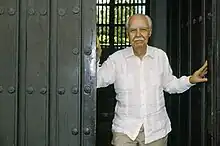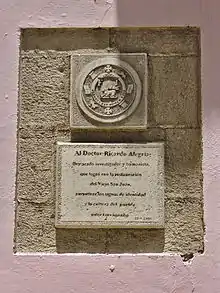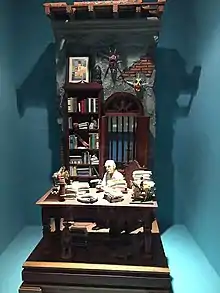Ricardo Alegría
Ricardo E. Alegría Gallardo[lower-alpha 1] (April 14, 1921 – July 7, 2011) was a Puerto Rican scholar, cultural anthropologist and archaeologist known as the "father of modern Puerto Rican archaeology".[1]
Ricardo Alegría | |
|---|---|
 | |
| Born | April 14, 1921 |
| Died | July 7, 2011 (aged 90) |
| Nationality | Puerto Rican |
| Occupation(s) | cultural anthropologist and archeologist |
| Spouse | Carmen Pons |
| Children | 1 |
Early years
Alegría was born in San Juan, Puerto Rico where he received his primary and secondary education. His father, José S. Alegría, was a former vice president and founding member of the Puerto Rican Nationalist Party. It was Alegría's father who instilled in him a sense of love and pride for Puerto Rico, its history, and culture.[lower-alpha 2] In 1941 at the University of Puerto Rico, together with Yamil Galib, Alegría founded a new fraternity, Alpha Beta Chi.[lower-alpha 3] In 1942, Alegría earned his Bachelor of Science degree in archeology from the University of Puerto Rico. He continued his academic education in the University of Chicago where in 1947 he earned his master's in Anthropology and History. In 1954, Alegría earned his Ph.D (doctorate) in Anthropology from Harvard University.[2]
Legacy and death
Alegría was named the first director of the Institute of Puerto Rican Culture by Luis Muñoz Marín, Puerto Rico's first elected governor. He was responsible for the creation of the "Archaeological Center of Investigation of the University of Puerto Rico"(UPR). Alegría also created the "Center of Popular Arts of the Puerto Rican Cultural Institute", the program of publication of books of the institute, and created the logo for the Institute of Neurobiology in Puerto Rico.
Alegría was responsible for the renovation and restoration of historical Old San Juan under the leadership of then San Juan mayor Felisa Rincón de Gautier. He also spearheaded restoration of the ruins of the Caparra Archaeological Site and Fortín de San Gerónimo. As a result of his work Old San Juan was declared a Historical World Treasure. In 1976, Alegría opened the Center of Advanced Studies of Puerto Rico and the Caribbean. In 1992, he established the Museum of the Americas.[4]
Alegría is considered a pioneer in the anthropologic studies of the Taino culture and the African heritage in Puerto Rico by the Smithsonian Institution.[5][lower-alpha 4] Caribbean Business points out that, "His extensive studies have helped historians understand how the Taínos lived and suffered, before and after the Spanish conquistadors arrived on the island."[3] Alegría estimated that about one third of all Puerto Ricans have Taíno blood—results of recent DNA studies have proved him right.[lower-alpha 5]
Nobel laureate Mario Vargas Llosa became inspired by Alegría's work and incorporated a fictional character based on him, named Ricardo Santurce, in his play El loco de los balcones.[lower-alpha 6]
Ricardo Alegría lived in Old San Juan in his later years, until his death on July 7, 2011.[lower-alpha 7] He had been hospitalized in San Juan's Centro Medico (Medical Center Hospital) a few weeks before his death. After a brief recovery, he relapsed, and was returned to the medical center, where he died of heart failure.[lower-alpha 8][lower-alpha 9]
Awards and recognitions

In 1993, President Bill Clinton presented Alegría with the "Charles Frankel Prize" for his contributions in the field of archaeology. In 1996, he was awarded the "James Smithson Bicentennial Medal". In 2001, Alegría received from the hands of Nancy Morejon "The Haydee Santamaria Medal" in Havana, Cuba. In 2002, Alegría received the "Luis Muñoz Marín Medal" in recognition of his life achievements from Puerto Rican Governor Sila Calderón. Puerto Rican artist Lorenzo Homar honored Alegría by making an artistic graphic poster of him.[8][9]

Alegría also received recognition from cultural and architectural organizations in Peru, Venezuela, Mexico and the Dominican Republic, where he also received an honorary doctorate. The city of Havana recognized his influence in the project to remodel the city's historical district (similar to Alegría's work in Old San Juan) by honoring him with a plaque, which, while he was alive, was the only monument honoring a living Puerto Rican in the entire city.
Puerto Rican folk duo Los Niños Estelares dedicated a tribute song to Alegría, named "Alegría, Doctor Alegría", in their 2010 album, Namasté. In it they describe many of Alegría's accomplishments, his educational background, and -partly in jest, due to Alegría's impressive credentials- likened him to Indiana Jones. In the lyrics, they name Alegría "the last Puerto Rican hero."
Works
The following is a list of books which Alegría has either authored or co-authored.
- "Ball Courts and Ceremonial Plazas in the West Indies" (1983)[10]
- "The three wishes; a collection of Puerto Rican folktales"(1969) ( with Lorenzo Homar)
- "History of the Indians of Puerto Rico" (1983)
- "El Instituto de Cultura Puertorriqueña, 1955–1973 : 18 años contribuyendo a fortalecer nuestra conciencia nacional" (1978)
- "Taino: Pre-Columbian Art & Culture from the Caribbean" (with Fatima Bercht and Jose J. Arrom) (1998)
- "Las primeras representaciones gráficas del indio americano, 1493–1523" (1978)
- "Descubrimiento, conquista y colonización de Puerto Rico, 1493–1599" (with Mela Pons Alegría) (1984)
- "Historia y Cultura de Puerto Rico: Desde La Epoca Pre-Colombina Hasta Nuestros Dias"
- "Excavations at Maria de La Cruz Cave & Hacienda Grande Village Site, Loiza, Puerto Rico" (with Irving Rouse) (1999)
- "La vida de Jesucristo según el santero puertorriqueño Florencio Cabán" (1983)
- "San Juan de Puerto Rico" (with Manuel Méndez Guerrero and María de los Angeles Castro Arroyo) (1989)
- "Cafe" (1967)
- "Programa De Parques Y Museos Del Instituto De Cultura Puertorriquena" (1973)
- "La Fiesta De Santiago Apostol En Loiza Aldea" (1954)
- "El Fuerte De San Jerónimo Del Boquerón" (1969)
- "El Ahijado De La Muerte"
Notes
- In this Spanish name, the first or paternal surname is Alegría and the second or maternal family name is Gallardo.
- Smithsonian Institution (2004) "I was greatly motivated by my father, the writer Jose Alegría, who taught me to dearly love Puerto Rico and to be proud of our history and culture."[2]
- Caribbean Business (2011) "Alegría earned his bachelor’s degree in archeology in 1942 at the University of Puerto Rico, where he founded the Alpha Beta Chi fraternity [...]"[3]
- Smithsonian Institution (2004) "Alegría was a pioneer scholar in the study of the culture of the Tainos, the native peoples who existed in Puerto Rico before Columbus’ arrival."[2]
- Caribbean Business (2011) "DNA studies have backed up Alegría’s estimate that about one-third of all Puerto Ricans have Taíno blood."[3]
- Caribbean Business (2011) "Peruvian Nobel laureate Mario Vargas Llosa was inspired by Alegría’s work and incorporated a fictional character based on him, named Ricardo Santurce, in his play “El loco de los balcones.”"[3]
- El Nuevo Día (2011; in Spanish) "El prestigioso profesor, figura indispensable en el desarrollo de la identidad cultural nacional, falleció hoy a las 6:05 a.m."[6]
- Primera Hora (2011; in Spanish) "Alegría Pons explicó que su padre salió del hospital en junio, donde le habían practicado un cateterismo y una angioplastia, pasó dos semanas en su casa, hasta que el domingo pasado le dio un dolor de pecho muy fuerte. Fue reingresado al Cardiovascular pero no pudieron hacerle otro cateterismo porque estaba muy débil."[7]
- Primera Hora (2011; in Spanish) "Alegría, de 90 años, falleció a eso de las 6:59 a.m. en la Unidad de Coronaria del Centro Cardiovascular de Puerto Rico y el Caribe [...]"[7]
References
- Arroyo, Efrén (July 7, 2011). "5 días de duelo por muerte de Don Ricardo Alegría" (in Spanish). WAPA-TV. Archived from the original on January 11, 2014. Retrieved January 1, 2014.
- "Biography: Ricardo E. Alegría". Smithsonian Institution. 2004. Archived from the original on March 4, 2016. Retrieved January 10, 2014.
- "PR scholar Ricardo Alegría dead at 90". Caribbean Business. July 7, 2011. Archived from the original on 2014-01-10. Retrieved January 10, 2014.
- "Ricardo Alegría" (in Spanish). Fundación Nacional para la Cultura Popular. July 11, 2011.
- http://www.lehman.edu/vpadvance/artgallery/gallery/images/taino_treasures/hernandez_essay_a.htm
- "Restos de Ricardo Alegría serán velados en el Centro de Estudios Avanzados". El Nuevo Día (in Spanish). July 7, 2011. Retrieved January 10, 2014.
- "Fallece don Ricardo Alegría". Primera Hora (in Spanish). July 7, 2011. Retrieved January 10, 2014.
- "Gray, Franklin awarded 1993 Charles Frankel Prize". chronicle.uchicago.edu. Retrieved 2019-09-13.
- "Ricardo Alegría - La Habana, Cuba - Citizen Memorials on Waymarking.com". www.waymarking.com. Retrieved 2019-09-13.
- Alegria, Ricardo E (September 14, 1983). Ball courts and ceremonial plazas in the West Indies. Dept. of Anthropology, Yale University. OCLC 635674732.